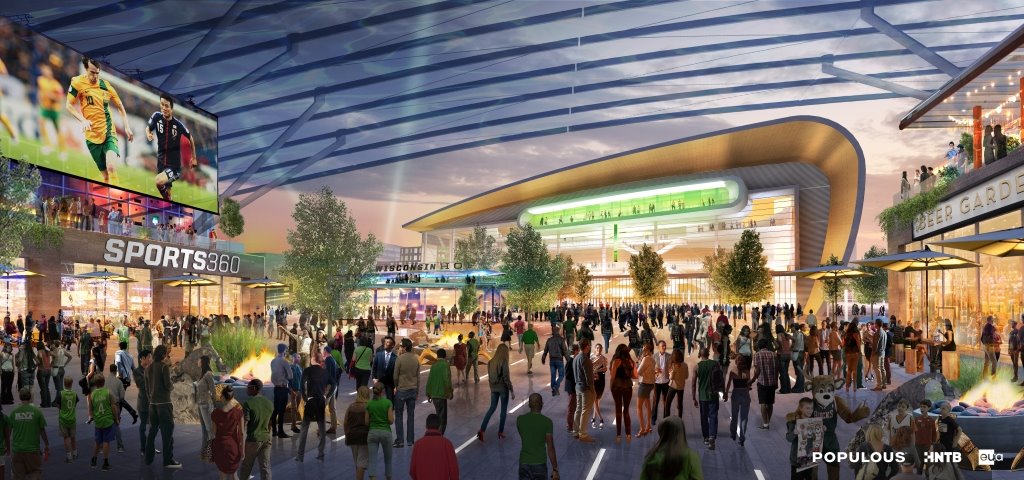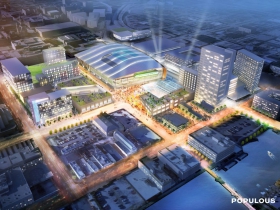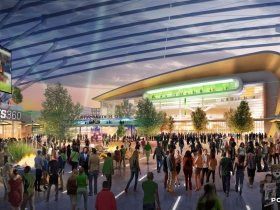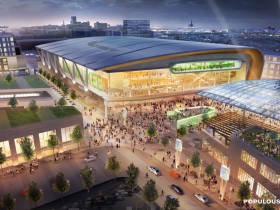Will Bucks Break Their Lease?
Why the new arena deal will not lock down the franchise in Milwaukee
The Legislature’s recent approval of an arena deal has Bucks fans cheering. Many believe a 30-year “clawback” clause requiring the Bucks to pay off remaining arena debt–if they try to leave early–will keep them in Milwaukee.
As a Bucks fan since 1968, I hope that’s true. But in reality, the finances of NBA basketball could make it easy for the team’s owners to move the franchise to a different city.
Fans viscerally experience victories and defeats. Franchise owners are also motivated by these emotions, but with an added, bottom-line incentive and with no home town loyalties. New principal owners–hedge-fund billionaires Wes Edens, Marc Lasry and Jamie Dinan—all live in Manhattan.
As hedge-fund operators, the Bucks owners specialize in acquiring “distressed assets,” the term Lasry used at the Bucks-sale press conference. Here’s the standard formula: Buy low. Improve value. Divest. Move on.
Being sports fans, Edens, Lasry and Dinan could indeed choose to own the Bucks long term. However, first and foremost they are ultra-savvy businessmen. Dallas Mavericks owner Mark Cuban told ESPN the sale of the Bucks for $550 million (really $450 million minus Herb Kohl’s pledge to spend $100 million on a new arena) was a “bargain,” based on a nine-year TV deal starting in 2016. The L.A. Clippers were recently sold for $2 billion. Forbes presently values the Bucks at $600 million—far below the league average of $1.1 billion per team. A new TV-rights deal for all NBA teams will yield a near-triple increase to $89 million a year. In other words, there are many potential bucks still to be realized from the Milwaukee Bucks.
With an arena deal, the Bucks are clearly on track to reach maximum resale value. The Bucks making it to the playoffs in 2015 also added value. Several coveted free-agents just signed for next season. Management is working hard to build interest and attendance. All according to the formula.
Add to that the arena naming-rights, which are estimated to gain the Bucks owners $120 million. Yes, the team agreed to pay for all maintenance costs of the arena, but in the facility’s early years that cost is likely to be low.
From a business perspective, the optimal time for current Bucks owners to cash out would be within five to ten years. Let’s assume the team’s performance continues improving, the fan base expands and income keeps rising. There will be no fiscal reason to sit on this asset indefinitely. A new arena will rapidly depreciate in value (as they all do) and require higher maintenance costs and the team’s play could certainly fluctuate. And future TV deals may level off, because cable customers are unlikely to absorb endless fee hikes.
Conservatively, let’s say a new owner pays $1.1 billion for the franchise in 2025 — the present average price. However, current Bucks owners would not have to require the team to stay here. That promise was only between Kohl and Edens/Lasry because of Kohl’s insistence.
What about the clawback clause in the public-funding deal? It offers some relief for taxpayers, but it basically defines known costs for breaking the arena lease/construction contract. Present and future owners would simply factor into a sale the remaining debt.
Here’s a ballpark tally of what Bucks owners would have to pay taxpayers if the team is sold and moves in 2025: Roughly half of the total principal borrowed by county and state–or $55 million—would be due. With prepayments and other costs, that could reach $60 million. Wisconsin Center District bonding of $93 million would still be outstanding, although ticket surcharges would have covered some accrued interest. Payback for city borrowing could be about $20 million. That’s around $173 million.
Perhaps I’m underestimating. Say they have to pay $200 million. That still gives them a $450 million gain from a $1.1 billion sale that involves the team leaving Milwaukee. That’s a nice return on investment.
The Bucks are also getting (mostly for free) about 30 acres of downtown Milwaukee real estate–a perk arranged by Milwaukee’s County Executive Chris Abele and Mayor Tom Barrett. All profits from selling or developing this appreciating real estate will be pure gravy for the shrewd billionaires.
What if new Bucks owners do move the team? As of 2025, taxpayers would have paid roughly $140 million in borrowing costs. Other asset giveaways to the Bucks will total at least $50 million. For that, we will have a tricked-out, 17,000-seat (but already-aging) arena for concerts and Marquette basketball games. The Wisconsin Center District would then need to manage and maintain it since the Bucks would be history.
It’s hard to gauge future arena costs to taxpayers minus an NBA anchor tenant. Some cities continue using arenas after a pro team’s departure, but they usually become white elephants.
Another potential white elephant will be the Bucks proposed “entertainment” mall. The Bucks hope to win over Milwaukee’s Common Council and build their block-long, multi-story bar-palooza on the site of a lucrative city-owned 4th and Highland Parking Structure. It’s anyone’s guess whether that project would be viable and if neighboring bars and restaurants will suffer in the process. But certainly the Live block’s central reason for being would disappear if the Bucks left town.
“Putting shovels in the ground” usually implies that a major business is establishing deep roots for generations to come. However, in today’s NBA, a franchise simply runs down an arbitrary 20-year (or less) arena time clock. Owners then demand a new and ever-changing list of “ancillary income streams” and upgrades from fans/citizens– or they threaten to leave town.
Let’s not delude ourselves that the current Bucks investors will treat their NBA franchise differently than any other “distressed asset.” Remember the formula? Buy low. Improve value. Divest. Move on.
Arena Renderings
Political Contributions Tracker
Displaying political contributions between people mentioned in this story. Learn more.
- June 29, 2017 - Tom Barrett received $1,000 from Herb Kohl
- March 3, 2016 - Tom Barrett received $5,000 from Herb Kohl

























My friends, brothers, neighbors, monkeys trainer said the Bucks might leave too. So that info, plus the speculation from this article, plus $1 dollar will get me a double cheese burger from McDonalds.
Kansas City Live is the one of the entertainment districts they’re modeling the arena area after. It does pretty well being right next to Sprint Center which doesn’t have an anchor tenant although it hosts a healthy amount of concerts and shows.
Is Pat Small Bruce Murphy’s new pen name?
Sure, if your definition of “pretty well” includes approximately $15 million dollars of support (making up for shortfalls in the promised tax revenue used to finance the project) per year in the last two (full) years:
2013: http://www.bizjournals.com/kansascity/print-edition/2013/07/12/power-light-district-kc-forks-over.html
2014: https://nextcity.org/features/view/kansas-city-mall-downtown-development-subsidies-cordish-companies
To those trolling the author, Will and D, what in this column do you not agree with? Poke holes in the logic. Show me what I’m missing because the financials described here make perfect sense to someone willing to sit on an investment for ten years and then move on.
@D Funny. No
The other NBA owners would still have to approve a sale and subsequent relocation.
@Rocko, NBA owners consider various factors in approving sales or moves. One could guess a top concern is how it affects their business prospects as owners. How it will impact any given city or its fans would likely be lower on that list. If owners could never relocate teams it would diminish the overall value of owning a team.
Can’t remember the last time UrbanMilwaukee posted one positive article or press release in regards to the arena, let alone a neutral one. More and more this site is just becoming a place to look at development picture updates.
Jerad,
This article listed about 30 winners in the arena deal and only a few losers…
http://urbanmilwaukee.com/2015/07/17/eyes-on-milwaukee-bucks-arena-winners-and-losers/
@JoeW
His flawed logic is assuming that the new ownership group views this as nothing more than a cash grab. What is this based on? Hypothetically, any professional sports team could be sold to some mystery buyer with endless amounts of cash. Rich people don’t buy sports teams to make a quick buck, they buy them because they are the ultimate luxury item. It assumes there is some decade long scheme of tricking the taxpayers, by three men who each are wealthy enough to own a team on their own. It’s basically fearmongering by the usual cowards in this city whose aversion to risk is why Milwaukee has been a economic/cultural backwater. On a website that features writers who care more about bike lanes and ripping Scott Walker than bold $1 billion dollar developments.
No, I’ll just assume that these guys are the new Attanasios, Ballmers, and Cubans. We will see what happens when they start developing around the arena site and the impact it will have on downtown. Nobody besides finance geeks knew who these owners were. Now, they have a chance to create a legacy for themselves on the basketball court and playing a role in the rebirth in a major American city. Those things are worth more to some people than whatever the payoff would be in a team sale.
I have no idea whether the Bucks owners have any long-term plans for the team in Milwaukee or not. I hope they do.
However, what is more disturbing is the idea that major league sports are demanding exceptional amounts of public funding for large infrastructure projects that clearly are slated for just a 30-year life span at most. The Bradley Center – which required public funding and in itself generated much public discussion – will in theory be disposed of in 2017 after 29 years of operation.
Whatever happened to our ability to create public infrastructure that can last for more than one generation? If we are to dedicate large amounts of public resources – money, land, community will – it would be nice to at least be sure that we wouldn’t make the children born this year have to go through all of the same angst before they can even start families of their own.
The author here is also assuming that the only penalty the Bucks would have to pay for breaking the lease is the remainder of the bonds, which is likely incorrect. The lease will probably include a specific performance clause, which makes the lease significantly harder and/or more expensive to break. This is pure fear-mongering with no actual thought to what a lease will actually look like.
Todd, Neil deMause, who has covered every pro sports-venue deal for over 20 years, wrote that it’s unusual–and risky–for legislators to approve a deal before a final deal is drafted. The lease can include loopholes and clauses that force taxpayers to cough up ever more money–or risk the team relocating. Horror stories abound. And cartels/team owners know how to write leases to their own advantage.
It’s possible that Walker’s Secy. of Administration will take this all into account and come up with a really airtight lease that would create too much pain for current or future owners to consider a move. That’s lot of pressure on one state administrator, who will have complete say about negotiating the 30-year lease.
Oklahoma City Thunder owners bought the Sonics pledging to stay put and then moved two years later.
Even if the Bucks stay here till it’s time for a new arena, taxpayers will pay at least $400 million for virtually no financial reward. State fiscal bureau projects at best $300M in player income taxes over 30 years. The team owners assume modest risk and are guaranteed massive rewards, starting with $89 million a year from TV, all naming rights & sponsor income, plus all revenue streams from the arena. Bucks owners can’t lose.
M.
Neil deMause is fine, and I read Field of Schemes quite frequently, but that’s not what the argument is in this article. The author here does not even pretend that there will be other protections in the lease to keep the team here. Also, Neil has a clear agenda, and while he makes some valid points, he also ignores that cities/states have gotten more savvy on lease negotiations.
The Sonics issue actually proves my point about the use of a specific performance clause. The new owners did not promise to keep the team in Seattle, they promised to make an effort to get a new arena built. They actually didn’t follow through on that promise, but that’s not a major point here. The Sonics lease ran through 2010, but in 2008 the team decided to move. Seattle sued the team, and while no one knows if they would have won, the team was so afraid of losing they settled by giving the city up to $75 million to leave the arena 2 years early (the team wound up only paying $45 million due to other issues). So the settlement was between $22.5-$37.5 million per year to break the lease. That much money gets expensive real quick, especially if you have to factor in a clawback provision.
But again, we’re all speculating here. The reality is, it’s not easy to break leases, they can be negotiated to a team’s favor, but they rarely get broken, and pretending (like this author does) that it is something to be concerned about is silly. It’s fear-mongering against a deal Urban Milwaukee doesn’t like. There are plenty of reasons to dislike this deal, but cooking the concern that is generated in this article is very weak.
Also, I am not arguing that the owners are going to lose out, they won’t, so I’m not sure why you decided to add that into a response to me.
Urban Milwaukee seems determined to see the cloud in the silver lining about the Bucks and the new owners. Kind of sad really. There is so very much positive going on in Milwaukee and the arena district is a big part of it. Why dwell constantly on the potential for negativity?
Whatever, guy. Knock yourself out.
Will the Bucks break their lease? Excellent question! While we are at it, let’s also discuss the question of whether the Bucks will hire a private mercenary army and declare themselves an independent state called Bucktopia.
I mean, since we’re coming up with fantasy questions we might as well, right?
Owners of NBA franchises don’t get into these things as a business, they do it because they want to own an NBA franchise. Just like the owner of vintage cars may make money when their cars appreciate… these are luxuries to flaunt or personal passions they are pursuing. The decision making process for buying any ole’ business vs the decision making process of buying a professional sports franchise is quite different.
AG, I like your Bucktopia name! Much better than Bucksville…A mercenary “army” may be far-fetched but New Orleans has a new massive private police force hired by one wealthy man there.
Todd, part of Neil D’s “clear agenda” is that he wants to keep enjoying pro sports (which he seems to love) without fans and taxpayers continually being taken to the cleaners. Of course, it’s the ultimate reward to own a sports team but the cartels make sure they are also huge profit machines. Franchises do not need gobs of public money to be viable, esp. in the current climate.
Esquire writer Charles Pierce, an MU grad and B-ball fan, weighed in on Bucks and other pending deals…
https://grantland.com/the-triangle/palace-intrigue-stadium-fights-explode-in-milwaukee-and-l-a/
Buck the trend, and get the best bang for the Bucks! Move the Bucks back in NBA time, to Sheboygan!! More value, more history, more economic impact, more statewide team support (ala Green Bay!). Support the move to Sheboygan!! http://www.facebook.com/sheboyganbucks
As many have noted, pro team owners may be mostly motivated by love of the game. However, there’s still a fair amount of team sales and moving around–or threats to do so. That intrigue can be as interesting to watch as the games themselves…
http://www.fieldofschemes.com/2015/08/12/9622/which-nfl-teams-will-go-to-la-no-can-predict-but-here-are-some-predictions-anyway/
@Marie
One article, and no surprise it’s written by Jeremey. (Who I very much respect)
Meanwhile there’s 100 of Bruce’s articles and press releases denouncing how the new owners are a scourge on Milwaukee’s taxpayers. I’ll look forward to everyone eating crow when the entirety of the Park East land west of the river is property tax paying, job producing, quality of life improving development.
Haaaaaaaaaaaa!!!!! Thanks for that laugh DNelson!
Public funding for an arena has been framed by boosters as a black-and-white issue. They say you’re either for whatever the Bucks have demanded or you’re anti-arena (and are hastening Milwaukee’s demise). Shining a light on deal components or their implications for taxpayers is often called “anti-arena.” Urban Milwaukee published numerous articles analyzing aspects of whatever was proposed at various stages, noting pros and cons. That used to be a common role of journalism, as opposed to “taking dictation” as some characterize simply printing variations of press releases.
UM published two press releases yesterday by politicians who voted for the arena. I recall an op-ed by MMAC’s Tim Sheehy in response to one written by Bruce Murphy. Michael Horne covered a forum conducted by arena boosters. I can’t recall all arena coverage, but it’s still accessible in UM’s archives. I would be surprised if UM has declined to print releases or stories that some might label pro-arena.
Jon Nichols, a fine Wisconsin and national journalist, co-wrote a thought-provoking book called “The Death and Life of American Journalism.” They looked at how democracy suffers when public-policy issues are not adequately analyzed. That’s happening more than ever for many reasons–the shrinking of print media being a major contributor. I’m grateful that Urban Milwaukee publishes in-depth journalism on many topics, including ones not commonly covered by other media. That includes pieces by the nonprofit Center for Investigative Journalism, Wisconsin Eye, Milwaukee Neighborhood News Service and other contributors. It’s not merely an echo chamber. Even these comments threads add to the vibrant dialog about public policy issues.
I think the coverage in here has been fair. The trouble is the rest of the media has taken a complete pass on covering this issue so it makes it seem as though Urban Milwaukee has an axe to grind. The Business Journal is practically cheerleading for it. The Journal-Sentinal is basically a stenographer for the Bucks as pointed out several times on the website Field of Schemes. So important questions just aren’t being asked such as:
– How much is the total subsidy?
– Why do we assume all this development will occur when the Bradley Center has never spurred much ancillary development?
– If this arena isn’t just for the Bucks why are the Admirals moving to UW Panther arena?
– What will happen to this development in 25 to 30 years when we inevitably need a new arena?
– Specifically what concert tours are skipping us now that will suddenly come to an arena that will actually be smaller than the current one?
– If it’s “cheaper to keep” the Bucks can’t the same argument be made for any other business out there to get some type of subsidy? Does NML generate more income taxes than the Bucks and if so, shouldn’t they get $250,000,000 for their new building? (I know the building has a TIF, but they will be paying real estate taxes on that property which the Bucks won’t have to)
As “M” points out this whole thing is seen by supporters as a black/white issue. Either you support this arena or you want Milwaukee to fail. Can’t a person just be against it because they are tired of seeing developers always feeding at the public trough. If a new arena makes fiscal sense, investors will invest in it and I suspect they would. However, why invest the money if the government is willing to give it to you for free. The owners keep their appreciating asset (the franchise) and the taxpayers get stuck with the depreciating asset (the arena).
If there are cost over-runs (as is typical of projects like this) who is on the hook to cover them? The city, county, state or the owners?
Casey, one good aspect of this deal is that the owners have to cover over-runs.
However, it seems the Bucks cleverly raised the projected cost to begin with. It went from $450M to $500M. Detroit is building an arena with 3,000 more seats for $450M. Our $500M will build some pretty snazzy suites, plenty of bars and restaurants, and gold cup-holders. I suspect some of it is funding all the upfront design costs of their “ancillary” development. How would we ever know?
Also, the actual lease has not been drafted, so nobody knows what the final deal will be. And that will only be between Walker-appointed Secretary of Administration Scott Neitzel and the Bucks, with no more voting on any part of it. Also, the Bucks will run the arena and get all revenue. As Mike noted, no other business gets to have taxpayers pay for at least half the costs of a new building every 25-30 years, plus getting free land, and a total tax exemption. Sports cartels are the new robber barons.
The New York Times analyzed the arena-funding deal–and cited this article among many sources. Also rustled up new details including that the Bucks or their subcontractors won’t have to pay for sewer work in Park East. Just to be nice, the city will pick up the tab, even though that cost was one of the reasons for the $1 price tag. Also, the Bucks rejected the city’s request for a 30-year commitment–so that’s not likely to show up in their lease.
http://www.nytimes.com/2015/08/15/sports/bucks-new-owners-get-house-warming-gift-of-public-money.html?smid=nytcore-ipad-share&smprod=nytcore-ipad
I doubt they will leave but having the discussion about the potential has value. It makes the constituents prepared to protect our interests. Having the BUCKS around for me has never been a AUTOMATIC money maker but we shall see…
Mike Bark,
There is a very big difference between the state income tax collected from the Bucks and that from NML: Nearly all of the Bucks income tax money comes from non-residents (people who pay taxes but consume very few government services within Wisconsin).
Just got back from the UP. In response to various comments, I am indeed not the pen name of Bruce Murphy (though I appreciate the compliment). Nor am I a fear-monger. I have been periodically speaking and writing about issues in Milwaukee for 50 years. I am also an inveterate lifelong sports fan. I am pro-Bucks and anti-extortion. I’ve also been a real-estate investor for 40 years.
Much of sports fandom involves following stats and making predictions based on numbers. For years, I’ve enjoyed using my own system of analyzing player, team and game stats in the NBA to assess outcomes.
As for pondering whether the Bucks might leave and implications of that, it’s based on steady trends of franchise movement over many decades. It’s still happening (or being threatened often) in all pro sports. I’m glad it’s slowed recently in the NBA. But that just shows that politicians could have called the Bucks’ bluff about threats to leave and fought to get a better deal. Many others who follow sports, including nationally, share that view.
Of course I hope that the Bucks stay in Milwaukee. I also maintain that we best approach issues about the arena with a bit more realism and healthy skepticism. For example, the Bucks should not get undue credit for every bit of new downtown development, especially since some of it was already underway. One more arena will likely spur and continue downtown redevelopment, including Park East. Bear in mind, however, that new development had been gaining momentum since even before the recession–despite the blowhards on talk radio and elsewhere who call Park East “a moonscape” while pushing pie-in-the-sky schemes and dreams of Wall Streeters “saving” Milwaukee with their PRESENCE.
Perhaps it’s now time for the Bucks to cough up some REAL THANK-YOU PRESENTS to Milwaukee in return for the public assets we’ve turned over to them. That’s happened in Detroit, Cleveland and elsewhere. I’m not holding my breath.